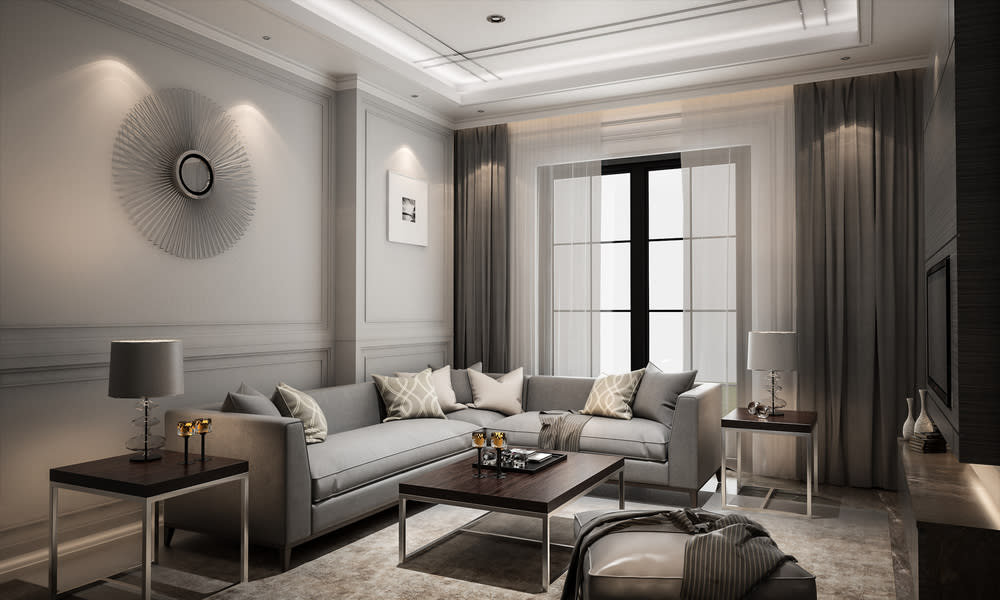
Interior Design Ideas for Living Room: Do’s and Don’ts While Designing
The living room serves as the centerpiece of your home—a space where family members gather, guests are entertained, and memories are made. Designing the perfect living room involves a delicate balance of functionality, comfort, and aesthetics.
Whether you’re starting from scratch or giving your living room a makeover, here are some essential do’s and don’ts to keep in mind:
Do:
-
Plan the Layout:
- Identify Activity Zones: Consider how you’ll use the space. Will you have a dedicated conversation area, a reading nook, or a home entertainment zone? Define these zones through furniture placement and area rugs.
- Traffic Flow is Key: Ensure smooth movement throughout the room. Avoid placing furniture too close together or blocking pathways.
-
Measure and Consider Furniture Scale:
-
- Sketch Your Layout: Draw a basic floor plan to scale, including furniture dimensions. This helps visualize the arrangement and identify potential space constraints.
- Proportional Furniture: Select furniture pieces that complement the room’s size. For instance, a petite loveseat might be ideal for a smaller living room, while a spacious sectional would suit a larger area.
-
Embrace the “Golden Rule” with Nuance:
- Focal Point Versatility: A fireplace or TV can be the focal point, but don’t be limited. A stunning bookshelf, a large piece of artwork, or even a unique architectural feature can serve the purpose.
- Conversation Areas: Arrange seating around the focal point to create conversation nooks. Include a mix of seating heights (sofas, armchairs) to encourage interaction.
-
Layer Rugs for Visual Interest:
- Area Rug Size: The rug should ideally extend at least a foot past the front legs of your largest furniture piece. This anchors the space and defines the living area.
- Layering Possibilities: A smaller rug layered underneath a coffee table adds a touch of personality and defines the seating area.
-
Welcome Natural Light, But Control It:
- Sheer Curtains: Maximize natural light during the day while maintaining privacy. Opt for sheer curtains that diffuse harsh sunlight and add a touch of softness.
- Window Treatments: Consider blinds or shades for additional light control, especially in the evenings or for watching movies.
-
Prioritize Seating and Consider Comfort:
- Guest Capacity: Ensure enough seating to comfortably accommodate the number of guests you typically entertain.
- Seating Variety: Mix and match seating options like sofas, armchairs, ottomans, and accent chairs to create a dynamic and inviting atmosphere.
- Comfort is Key: Choose furniture with comfortable cushions and supportive backrests.
-
Lighting: A Multi-Layered Approach:
- Ambient Lighting: Overhead lighting like chandeliers or recessed lights provide general illumination.
- Task Lighting: Table lamps and floor lamps offer focused lighting for reading, working, or playing games.
- Accent Lighting: Pendant lights, sconces, or strategically placed lamps can highlight artwork, architectural features, or create a warm ambiance.
Don’ts:
-
Overcrowd the Space:
- Walking the Tightrope: Maintain a comfortable distance between furniture pieces and walls (ideally 18-24 inches) to allow for easy movement and prevent a cramped feeling.
- Less is More: While filling empty spaces may seem tempting, avoid cluttering the room with excessive furniture or decor.
-
Ignore Scale and Proportion:
- Scaling Down for Small Spaces: Opt for furniture with clean lines and slender profiles in smaller living rooms. Avoid bulky pieces that overwhelm the space.
- Filling Large Spaces: In larger rooms, incorporate furniture groupings and area rugs to define different zones and create a sense of intimacy.
-
Neglect the Flow:
- Clear Passage: Ensure furniture placement doesn’t obstruct walkways or make it difficult to navigate the room.
- Consider Furniture Movement: Living rooms are often multi-functional spaces. Choose furniture that can be easily moved or rearranged to accommodate different activities.
-
Forget Functionality:
- Lifestyle Choices: Select furniture that suits your needs. If you have pets or young children, consider durable and easy-to-clean materials.
- Storage Solutions: Incorporate storage ottomans, coffee tables with drawers, or built-in shelves to keep the space organized and clutter-free.
-
Underestimate the Power of Color:
- Color Psychology: Consider the mood you want to set. Warm colors like yellow and orange create a cozy feel, while cool colors like blue and green promote relaxation.
- Neutral Base: Opt for a neutral color palette for the walls to provide a foundation and allow pops of color through furniture, artwork, and accessories.
-
Neglect Personal Touches:
- Tell Your Story: Showcase your personality through unique decorative elements.
- Curated Collections: Display artwork, family photos, travel souvenirs, or other meaningful items that reflect your interests and hobbies.
Bonus Tips:
-
Play with Patterns and Textures:
- Visual Interest: Mix and match patterns and textures on throw pillows, rugs, and upholstery. However, avoid overwhelming the space with too much busyness.
- Balance is Key: Maintain a cohesive look by incorporating a dominant pattern or texture and complementing it with subtle elements.
Experienced interior designers at MyInstaSpaces can assist with space planning, furniture selection, and creating a cohesive aesthetic. We can help you achieve your vision and ensure your living room reflects your unique style and needs.













Leave a Reply